2018-2019学年最新牛津译林版(7A)英语全册教案
- 格式:doc
- 大小:3.99 MB
- 文档页数:189
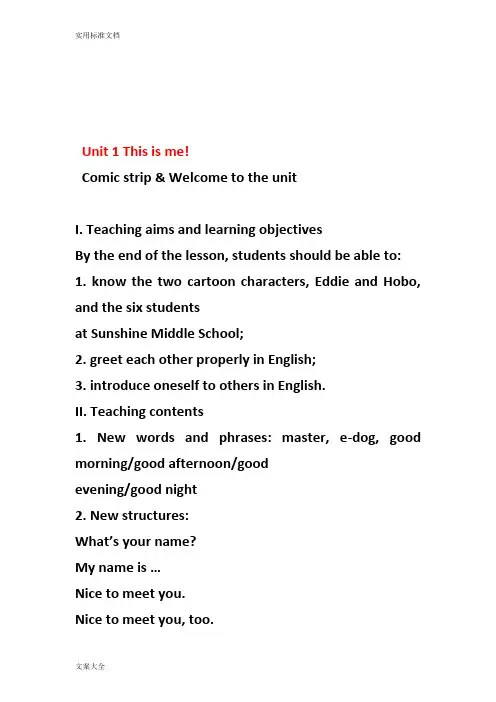
Unit 1 This is me!Comic strip & Welcome to the unitI. Teaching aims and learning objectivesBy the end of the lesson, students should be able to: 1. know the two cartoon characters, Eddie and Hobo, and the six studentsat Sunshine Middle School;2. greet each other properly in English;3. introduce oneself to others in English.II. Teaching contents1. New words and phrases: master, e-dog, good morning/good afternoon/goodevening/good night2. New structures:Wha t’s your name?My name is …Nice to meet you.Nice to meet you, too.III. Focus of the lesson and predicted area of difficultyHow to introduce each other and greet each other in English.IV. Teaching proceduresComic stripStep 1 Lead-in:En joy the video “make friends”.T: Today we’ll learn Unit 1 This is me! Do you like the song in the video?We are now new students at Donglin Middle School, and meet many newclassmates. Do you want to make more friends? I’d like you to meet twonew friends in our books. Do you want to know them? 【设计意图:由视频再到图片make friends引出不同人物的名字。
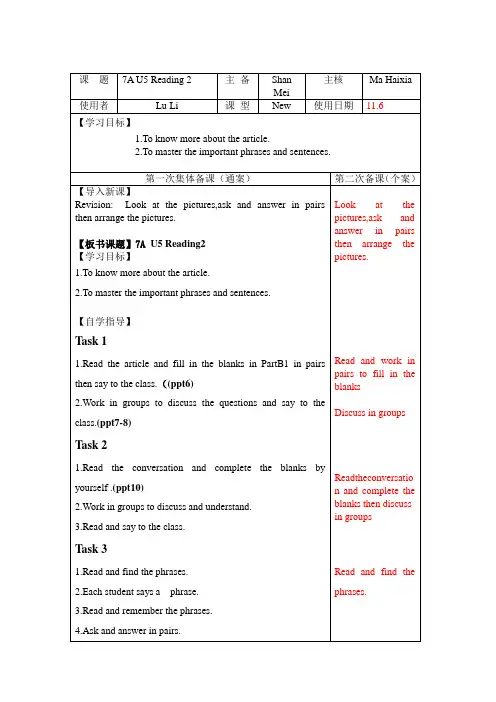
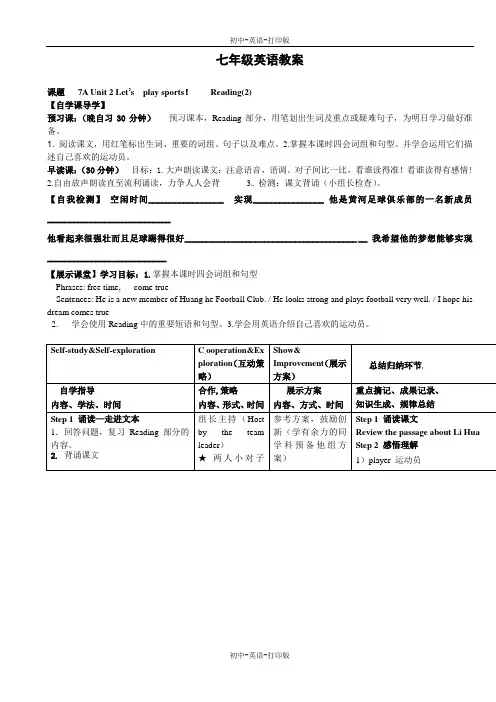
七年级英语教案课题7A Unit 2 Let’s play sports!Reading(2)【自学课导学】预习课:(晚自习30分钟)预习课本,Reading部分,用笔划出生词及重点或疑难句子,为明日学习做好准备。
1.阅读课文,用红笔标出生词、重要的词组、句子以及难点。
2.掌握本课时四会词组和句型。
并学会运用它们描述自己喜欢的运动员。
早读课:(30分钟)目标:1.大声朗读课文:注意语音,语调。
对子间比一比,看谁读得准!看谁读得有感情!2.自由放声朗读直至流利诵读,力争人人会背3. 检测:课文背诵(小组长检查)。
【自我检测】空闲时间_________________ 实现________________ 他是黄河足球俱乐部的一名新成员____________________________他看起来很强壮而且足球踢得很好_________________________________________ 我希望他的梦想能够实现___________________________【展示课堂】学习目标:1.掌握本课时四会词组和句型Phrases: free time, come trueSentences: He is a new member of Huang he Football Club. / He looks strong and plays football very well. / I hope his dream comes true2. 学会使用Reading中的重要短语和句型。
3.学会用英语介绍自己喜欢的运动员。
Self-study&Self-exploration C ooperation&Exploration(互动策Show&Improvement(展示总结归纳环节Step2 感悟理解牵引寻读 1.迅速浏览学习目标处的生词、短语及句子,拿出红笔在文中划出来。
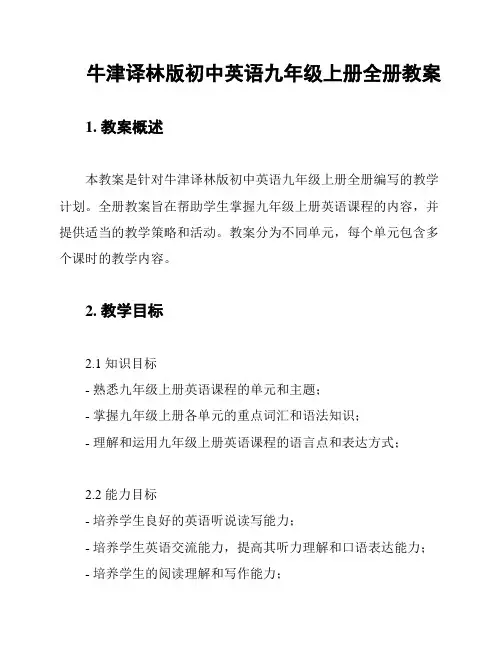
牛津译林版初中英语九年级上册全册教案1. 教案概述本教案是针对牛津译林版初中英语九年级上册全册编写的教学计划。
全册教案旨在帮助学生掌握九年级上册英语课程的内容,并提供适当的教学策略和活动。
教案分为不同单元,每个单元包含多个课时的教学内容。
2. 教学目标2.1 知识目标- 熟悉九年级上册英语课程的单元和主题;- 掌握九年级上册各单元的重点词汇和语法知识;- 理解和运用九年级上册英语课程的语言点和表达方式;2.2 能力目标- 培养学生良好的英语听说读写能力;- 培养学生英语交流能力,提高其听力理解和口语表达能力;- 培养学生的阅读理解和写作能力;2.3 情感目标- 培养学生对英语研究的兴趣和自信心;- 培养学生合作与交流的意识,提高其团队合作能力;- 培养学生的跨文化意识和国际视野;3. 教学内容本教案根据九年级上册英语课程的单元划分,每个单元包含多个教学课时。
其中,每个课时包括教学目标、教学过程和教学评价等内容。
具体的教学内容包括:- 单元主题和背景知识介绍;- 课文和课文理解的讲解;- 语法知识的讲解和练;- 听力和口语练;- 阅读理解和写作练;- 小组活动和课堂展示;4. 教学策略4.1 动手实践策略- 利用实际情境和场景创设,激发学生的研究兴趣;- 引导学生参与角色扮演、小组合作等互动活动,提高学生的实际应用能力;4.2 辅助工具策略- 利用多媒体教学辅助工具,如投影仪、音频设备等,增强教学效果;- 提供相关研究资源,如教学视频、课件等,帮助学生巩固研究;4.3 多元化评价策略- 采用多种评价方式,如口头测试、书面测试、小组作业等,全面了解学生的研究情况;- 鼓励学生自我评价和互相评价,促进学生的自主研究和互助研究;5. 教学评价根据教学目标和教学内容,本教案提供了相应的教学评价,包括作业评价、测试评价和课堂表现评价等。
通过定期的评价和反馈,可以及时了解学生的研究情况,调整教学策略,提高教学效果。
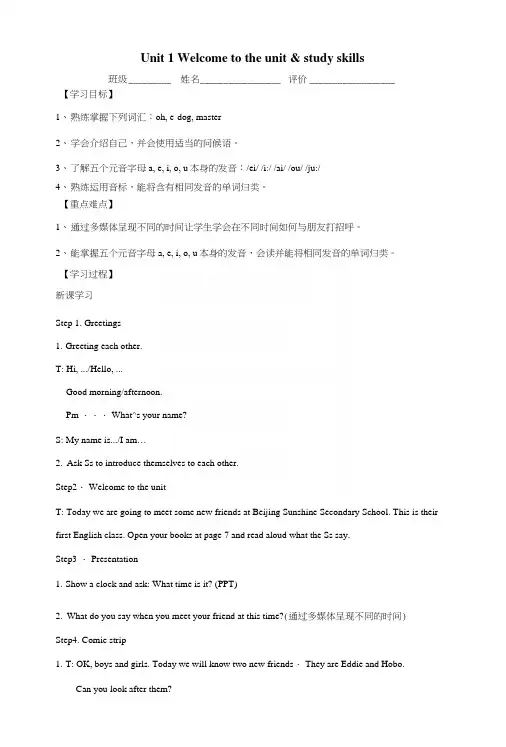
Unit 1 Welcome to the unit & study skills班级_________ 姓名_________________ 评价__________________【学习目标】1、熟练掌握下列词汇:oh, e-dog, master2、学会介绍自己,并会使用适当的问候语。
3、了解五个元音字母a, e, i, o, u本身的发音:/ei/ /i:/ /ai/ /ou/ /ju:/4、熟练运用音标,能将含有相同发音的单词归类。
【重点难点】1、通过多媒体呈现不同的时间让学生学会在不同时间如何与朋友打招呼。
2、能掌握五个元音字母a, e, i, o, u本身的发音,会读并能将相同发音的单词归类。
【学习过程】新课学习Step 1. Greetings1.Greeting each other.T: Hi, .../Hello, ...Good morning/afternoon.Pm ・・・ What^s your name?S: My name is.../I am…2.Ask Ss to introduce themselves to each other.Step2・ Welcome to the unitT: Today we are going to meet some new friends at Beijing Sunshine Secondary School. This is their first English class. Open your books at page 7 and read aloud what the Ss say.Step3 ・ Presentation1.Show a clock and ask: What time is it? (PPT)2.What do you say when you meet your friend at this time?(通过多媒体呈现不同的时间)Step4. Comic strip1.T: OK, boys and girls. Today we will know two new friends・ They are Eddie and Hobo.Can you look after them?总结:look after = take care of 照顾,照料我妈妈把我照顾的非常好。
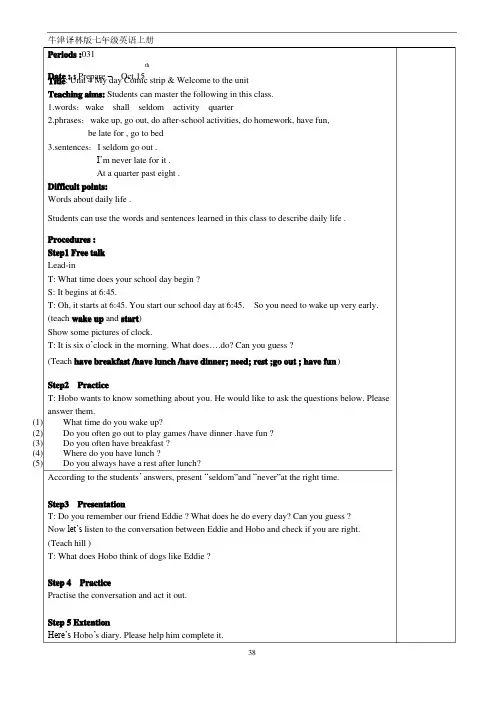
38 牛津译林版七年级英语上册牛津译林版七年级英语上册Periods :031Date : : Prepare – Oct.15th Title : Unit 4 My day Comic strip & Welcome to the unitTeaching aims: Students can master the following in this class.1.words :wake shall seldom activity quarter2.phrases :wake up, go out, do after-school activities, do homework, have fun,be late for , go to bed 3.sentences :I seldom go out .I’m never late for it .At a quarter past eight . Difficult points:Words about daily life .Students can use the words and sentences learned in this class to describe daily life .Procedures :Step1 Free talkLead-inT: What time does your school day begin ?S: It begins at 6:45.T: Oh, it starts at 6:45. You start our school day at 6:45. So you need to wake up very early. (teach wake up and start )Show some pictures of clock.T: It is six o ’clock in the morning. What does ….do? Can you guess ?(Teach have breakfast /have lunch /have dinner; need; rest ;go out ; have fun )Step2 PracticeT: Hobo wants to know something about you. He would like to ask the questions below. Please answer them.(1) What time do you wake up?(2) Do you often go out to play games /have dinner .have fun ?(3) Do you often have breakfast ?(4) Where do you have lunch ?(5) Do you always have a rest after lunch?According to the students ’ answers, present “seldom ”and “never ”at the right time.Step3 PresentationT: Do you remember our friend Eddie ? What does he do every day? Can you guess ?Now let’s listen to the conversation between Eddie and Hobo and check if you are right. (Teach hill )T: What does Hobo think of dogs like Eddie ?Step 4 PracticePractise the conversation and act it out.Step 5 ExtentionHere’s Hobo ’s diary. Please help him complete it.It is sunny today. I would like to go________. I like sports and I always go walking in the ____________. But my friend Eddie is lazy. He ___________does sports. He _________up very late.And then he wants to have __________. After it, he sleeps again. When he finishes his lunch, he says he ________a good _______ once more.Oh, my God ! His life is eating and sleeping. I think some dogs ________don’t know how to have____________.Step 6 PresentationT: Do you want to be lazy like Eddie? What time do you wake up every morning ? What time do you have breakfast / lunch / dinner /every day ? Why do you get up so early ?(Teach quarter, past, get up and be late for, have lessons/have classes. do after-school activities, do homework, go to bed …)Step 7 PractiseLook at the table of Millie’s day. Answer some questions.Look at the times on the blackboard. Please tell me your activities at these times.6:30 a.m 7:00 a.m 8:00 a.m 11:50 a.m4:30 p.m 6:00 p.m 8:00p.m 9:00 p.mMake sentences with “I _________________ at_____________.”Step 8 PresentationPart BT: Millie is busy every day. Now, she is telling her aunt about her school life. Let’s listen to their conversation and answer my question: Is Millie often late for school ?S: No. She is never late for school.T: Millie is a good student. She is never late for school. What about you? Are you often late for school? Are you never late for school?Step 9 PractiseRead Part B and practice it .T: Are your daily activities the same as Millie’s ? Now, you can complete the table on the right with your own information.…….T: Now time for you. I’d like you to work in groups of four to discuss your own day. You can use Millie and her aunt’s conversation as a model.Homework :1. Learn the new words by heart.2.Finish the exercisesAfterthoughts :Periods :032-033Date : : Prepare – Oct.15thTitle: Unit 4 My day ReadingTeaching aims:1. Students can master new words and expressions.2. Students can learn some new phrases: chat with best wishes have a good time3. Students can learn some new sentences:Our school starts at eight in the morning from Monday to Friday.Usually we do morning exercises first.Procedures :Step1 Free talk1.Do you have a full(充实的)充实的) and busy day?2.What do you usually do every day?Step2 PresentationListen to the passage and choose a title for this e-mail.Step3 ScaningRead the passage quickly and silently and do “T” or “F” questions in pairs.(partB2)Setp4 SkimmingRead the article again and do more exercises. (partB1)Step5 RetellingRetell Millie’s school life . Fill in the blanks.( partB3)Step6 Language pointsSome language points :a lot of = lots ofSometimes , some times , sometime , some timehave a good timeHomework :1. Learn the new words by heart.2.Finish off the exercises.Afterthoughts :Periods :034-035Date : : Prepare – Oct.18thTitle: Unit 4 My day GrammarTeaching aims:1. Students can use the prepositions correctly.2. Students can use the adverbs of frequency correctly.Difficult points: the usage of the prepositionsProcedures :Step1 Presentation1. Free talk .Use some questions to lead the usage of the prepositions .eg: What time do you go to school?When is your birthday?2. P47表格,教师归纳总结,领读例句。
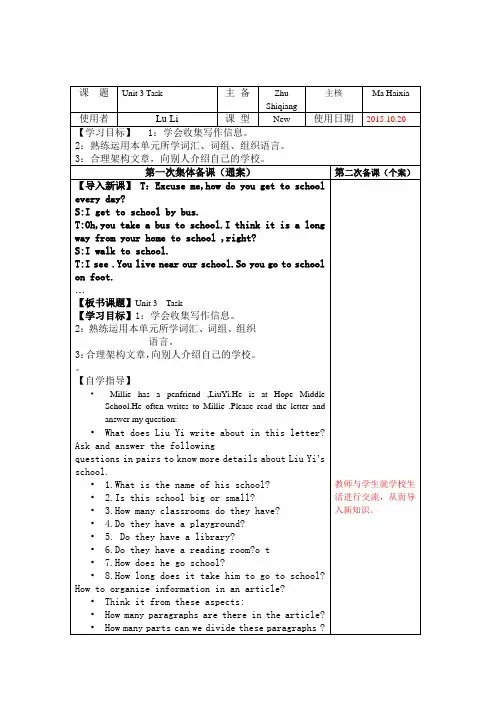

备课笔记学科英语班级一年级教师_____2018-2019学年度第一学期小学备课要求1.认真学习新课标,明确年段教学目标,对照新课标通读教材,了解编写意图,熟悉编排体系,明确教学任务,把握重点和难点。
2.要有学期教学计划和进度安排,坚持以组或单元为单位整体备课,要有详细的单元分析。
3.正确使用有关资料,整合教学资源,进行集体备课。
上课前教师还要认真熟悉教案、思考教案,结合本班学生的实际情况修改教案,进行有效的二次备课。
4.设计教案要做到五明确,即目的要求明确、重点难点明确、基本教法明确、学法指导明确、板书内容明确。
每课时教案都必须有比较明确的教学目标和重点难点,教学内容适当地分配,切忌平均用力。
5.教案内容要完整,即教学内容、目的要求、重点难点、课前准备、主要过程、板书设计、课堂小结、作业设计、课后记一应俱全。
教学程序设计中,教师活动和学生活动应明确。
严禁漏备或无教案上课。
6.作业安排要具体、适量,体现因材施教的原则,提倡教师进行原创性作业设计。
7.及时、认真地撰写课后记,针对教案和教学中的得失进行反思。
坚持每课都写课后记,每月完成一篇质量较高的教学反思。
8.超前一周写好教案,青年教师应备详细的教案,重在规范,有经验的中老年教师重在创新。
附:电子备课格式:(1)字体:标题黑体、正文宋体(2)字号:课题小二号、正文小四号(3)行距:1.25学期教学计划班级概况一(1)班和一(2)班各有学生21人, 23人。
有部分的学生在幼儿园或多或少学过一些英语,但是大部分孩子从未接触过。
对于这些新入学的小学生来说要同时面对中文和英语两门新的语言的学习,在一定程度上有些困难,因此作为教师就要客观遵循这个年龄段孩子的身心发展特点,运用各种教学手段,创造良好的学习时机,努力培养他们对英语的学习兴趣和学习习惯,使他们喜爱英语这门学科,继而学有所得。
教学内容《译林小学英语》一年级上册每个单元由Story time,Fun time,Song time/Rhyme time三个板块组成。
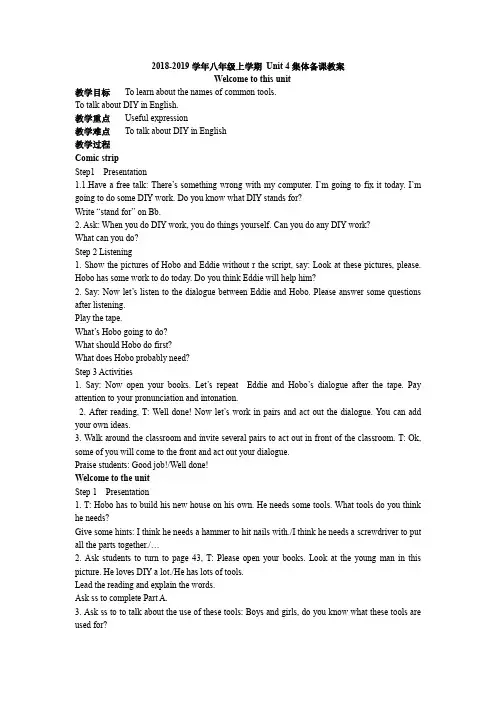
2018-2019学年八年级上学期Unit 4集体备课教案Welcome to this unit教学目标To learn about the names of common tools.To talk about DIY in English.教学重点Useful expression教学难点To talk about DIY in English教学过程Comic stripStep1 Presentation1.1.Have a free talk: There’s something wrong with my computer. I’m going to fix it today. I’m going to do some DIY work. Do you know what DIY stands for?Write “stand for” on Bb.2. Ask: When you do DIY work, you do things yourself. Can you do any DIY work?What can you do?Step 2 Listening1. Show the pictures of Hobo and Eddie without r the script, say: Look at these pictures, please. Hobo has some work to do today. Do you think Eddie will help him?2. Say: Now let’s listen to the dialogue between Eddie and Hobo. Please answer some questions after listening.Play the tape.What’s Hobo going to do?What should Hobo do first?What does Hobo probably need?Step 3 Activities1. Say: Now open your books. Let’s repeat Eddie and Hobo’s dialogue after the tape. Pay attention to your pronunciation and intonation.2. After reading, T: Well done! Now le t’s work in pairs and act out the dialogue. You can add your own ideas.3. Walk around the classroom and invite several pairs to act out in front of the classroom. T: Ok, some of you will come to the front and act out your dialogue.Praise students: Good job!/Well done!Welcome to the unitStep 1 Presentation1. T: Hobo has to build his new house on his own. He needs some tools. What tools do you think he needs?Give some hints: I think he needs a hammer to hit nails with./I think he needs a screwdriver to put all the parts together./…2. Ask students to turn to page 43, T: Please open your books. Look at the young man in this picture. He loves DIY a lot./He has lots of tools.Lead the reading and explain the words.Ask ss to complete Part A.3. Ask ss to to talk about the use of these tools: Boys and girls, do you know what these tools are used for?Step 2 Activities1. T: Millie and Suzy are also talking about DIY. Listen to them and tell me what Suzy is going to do today. Play the tape.2. Have ss turn to page 43,T: Open your books, please These two teams will read Millie’s part and those two will read Suzy’s part. Then change parts.3. T: Boys and girls, it’s your turn to talk about some DIY work that you would like to do. You have three minutes. You can use Millie and Suzy’s conversation as a model.Ss can prepare for three minutes, T walk around the classroom and choose several pairs to act out. Praise ss that do well: Very good/Great!Step 3 Homework1. Read the words ,phrases and sentences fluently.2. Memorize Comic strip and part B.3. Preview Reading.8A Unit 4 Reading (1)教学目标To learn about vocabulary about DIY.To understand the article and finish relative exercise.To cultivate the sense of DIY.教学重点To understand the article and finish relative exercise.教学难点To cultivate the sense of DIY教学过程Step1 Presentation1. Review the vocabulary of tools.2. T:Suzy’s cousin Andrew likes DIY a lot. He’s crazy about DIY.Write “be crazy about” on Bb.3. Present a picture of Andrew and ask : Look at this picture. What happened to Andrew? Encourage ss to answer.Write “pipe, fill…with…”on Bb.T: Yes, it’s terrible.Write “terrible” on Bb and ask ss to guess its meaning.Lead the reading.Step 2 Practice1. T: Millie wants to retell Suzy’s story about DIY. Listen to Suzy’s article carefully and read the sentences in Part B3 on page 46. Write a T if the sentence is true or an F if it is false.Play the recording of page 44, ask ss to do Part B3 on page 46.2.T: Read the sentences and correct those with wrong information:(3) Suzy’s cousin wanted to put up a picture on the wall.(4) Suzy’s cousin thought the living room was boring, so he painted it blue.(5) It took Suzy’s cousin five hours to put up the shelf on the wall.(6) Suzy’s cousin thinks he already knows everything about DIY.Then read the corrected sentences together.Step 3 Reading1. T: Listen to the article again and make some notes about it. Play the tape again. Pause between the middle, give the ss enough time to finish the note.2.T: Please open your books and turn to page44.Let’s repeat the article after the tape sentence by sentence. Pay attention to your pronunciation and intonation.Play the tape.Show some key words and phrases in each paragraph.3. Present all the key words and phrases.T: Close your books, please. Use these key words and useful phrases to retell the article. Paragraph 1: be crazy about, repair, decorate, look terribleParagraph 2: a brighter light, make a mistake, power cut, put up a picture, hit a pipe, fill…with…Paragraph 3: living room, boring, paint…blue, ceiling, floor, catParagraph 4: a shelf, above, spend five hours, not stay, much higherParagraph 5: buy, advise, make him angry, attend lessons, know much more4. T: Can you retell Suzy’s story about her cousin in your own words?Praise ss who can organizeStep 4 Homework.1. Read the article fluently, memorize the vocabulary, phrases and sentences.2. More able students to recite the text.3. Finish the relative exercise.8A Unit 4 Reading (2)教学目标1. To learn about vocabulary about DIY.2. To understand the article and finish relative exercise.3. To cultivate the sense of DIY.教学重点To learn some useful expressions and use them in different context教学难点To cultivate the sense of DIY教学过程Step 1. Leading inT: Yesterday we learnt the story of Andrew and his DIY jobs. Can you say something about Andrew?Ste p 2. PresentationA. Reading: Let the Ss read the context carefully and then answer the QS.1.)What is Andrew crazy about ?2.) What does he love to do ?3.) Is he good at DIY ? Why ?4.) How long did Andrew put up the shelf on the wall ?5.) If you were Andrew , how would you paint the living room ?6.)What did Suzy advise him to do ?B、Say Andrew and his DIY jobs and what problems he caused , then discuss how to solve these problems.C、Translate the useful expressions:1. put in a brighter light2. have a power cut3. make a mistake4. put up a picture on the wall5. hit a pipe6. fill the room with water7.keep on doing sth. 8. not only...but also...9.put up the shelf 10. advise sb.to do11. take a course in DIY 12. make him angry13. attend lessonsD、Language pointsAsk Ss to highlight the words、phrases、sentences they do not know. Then ask them to discuss them in pairs and try to work out the meanings from the context . At last the teacher tries to help them and explain the language points .Step 3. practiceGet the students to read the passage together aloud again,1)Now you know Andrew and his DIY jobs well. Can you retell the text ?2)Complete the conversation on Page 46 B4.3) Here is a DIY advertisements ,can you finish it ?Want to ( 安装电灯) . ( put in a light )Want to ( 修理坏掉的水管) . ( repair the broken pipe )Don't know how to deal with (停电) . ( a power cut )We ( 建议) you ( 修一门课程) in DIY . ( advise , take a course )You can ( 上课) every weekend . (attend lessons)Call us on 88221546 .Step 4. ActivitiesEnjoy DIY :Ask Ss to work in groups ,according to the teacher's instructions to do their DIY jobsA:Having a discussion in groupsGroup 1 : making a lovely envelopeGroup 2 : making a birthday cardGroup 3 :painting the paperB: Group presentationStep5 ExerciseFinish the relative exercise.Step 6 Homework1、To recite the text .2、Write a passage about how to do your DIY jobs ( such as painting a room , fixing a bicycle , making cakes, repairing computers )3、Preview Grammar8A Unit 4 Grammar A教学目标1. To master the new words.2. To use imperative sentences to give instructions.3. To use imperative sentences to give instructions in correct context.教学重点 1. To use imperative sentences to give instructions.2. To use imperative sentences to give instructions in correct context.教学难点As above教学过程Step 1 GreetingsOne-minute speech about the article.Step 2 Lead in1. Play a gameGive instructions.E.g. Please have a seat!Sit down please!Open the door!Please don’t close the window!………Step 3 Presentation1. Write these sentences on Bb and ask ss to discuss the structure.Put up a picture on the wall.Don’t stand on the desk.Please pass the book to me.2. Sum up the structure: We start a sentence with the base form of a verb when we want to tell people what to do. We add do not/don’t in front of the verb when we want to tell people not to do something. We often add please in a sentence if we want to give instructions politely.3. T: Now open your books and turn to page 47, please. Let’s read the sentences together.Step4 Practice1. Present the pictures of making cards: Please look at these four pictures. What’s Millie doing? Then ask: Do you know how to make cards? What should we do first?Have ss guess the meaning of “cut”, lead the reading.2. T: Open your books and turn to page 47. Look at the pictures carefully. Can you help Millie complete the instructions?Have ss watch the pictures and finish the exercise.3. T: Let’s read the sentences together.Check answers together.Step 5 Activities1. T:Now let’s play a game. I’ll tell you what to do and please follow my instructions.(1) Touch your nose.(2) Stand up.(3) Put up your books open.(4) Don’t keep your books open.(5) Don’t close your eyes.2. Play a game called “Eddie says …” Ask all the students to stand up, the teacher is the judge. Game begins, the teacher give the instructions. E.g.Eddie says “stand up”Ask ss to respond to teacher’s instructions quickly.3. 将下列句子改成肯定否定祈使句Come here early.Ask him.Don’t climb the tree.Read the book carefully.Don’t wait for her.Homework1.Preview Grammar B2.Finish the relative exercise.8A Unit 4 Grammar B教学目标1. To master the new words.2. To use should/had better to give advice.3. To use should/had better to give advice in correct context.教学重点 1. To use should/had better to give advice.2. To use should/had better to give advice in correct context.教学难点As above教学过程Step 1 Presentation1.Review Reading to introduce the usage of “should”T: Suzy doesn’t think her cousin knows much about DIY either. What did she advise him to do? T: What do you think she said to him about this?Write this sentence on Bb and mark the word should in red.2. T:Do you think we can use had better instead of should in this sentence?Write “You had better take a course in DIY.”Ask ss to think and understand the meaning of the two sentences.3. Present more sentences, encourage ss to sum up the rule: Here are some more sentences. Can you work out when to use should and had better?(1)To keep fit, you should /had better have a healthy diet.(2)You should not /had better not leave litter.(3)It’s going to rain. You should/had better take an umbrella.4.Work out the rule with ss: We use should and had better when giving advice and telling people what we think is the best or right thing to do. The tone of had better is strong than should.5. Please open your books and turn to page 48. Let’s read the sentences together.Step 2 Practice1. T: Suzy is giving DIY advice to her classmates. Can you help her make sentences withshould(not) and had better(not)?Have ss do exercise on page 48, and then read and check answers together.2. T: You’re giving advice to your friends. Rewrite the following sentences using should(not) and had better(not):(1) It’s time for class. Put your comic books away.(You should/had better put your comic books away.)(2)Your English is not good enough. Read more to improve it.(You should/had better read more to improve it)(3)Turn your mobile phone off in class.(You should/had better turn your mobile phone off in class.)(4) Don’t make the mistake again.(You should/had better not make the mistake again.)3.T: Boys and girls ,you have learnt how to give advice. I have a problem and I need your help. I can’t sleep well at night and I feel tired during the day. Can you give me some advice? Encourage ss to give advice:You should drink a glass of milk before going to bed./ You should not watch TV just before going to sleep./You had better do some reading before you go to sleep./…4.T: Work in pairs. Talk about your problems and try to give useful advice.Homework1.Preview Grammar2.Finish the relative exercise.8A Unit 4 Integrated skills教学目标1. To obtain relative information through listening.2. To talk about DIY in English.3. To strength the listening, speaking, reading and writing skills.教学重点1. To talk about DIY in English.2. To strength the listening, speaking, reading and writing skills.教学过程A .How to make a fruit saladStep 1 Presentation1. Communicate with ss to lead in new lessons: What did you have for breakfast/lunch today? What food do you like best? Do you have a healthy diet? Can you cook dinner on your own?2. Present the picture of salad and ask: Look at the picture .This is my favorite food. What is it? Yes, it’s a salad.Write salad on Bb and teach the new words.T: Salad is healthy. Do you like it? Do you think it’s easy to make a salad? Can you make a salad?3. T: What do you need when making a salad?Write spoon and cream on Bb, teach the new words and explain.Step 2 Listening1. T: Open your books and turn to page 49. Look at the pictures in Part A1.T: When we make a salad, we need some tools and we can add anything we like. Can you name the things in the pictures?Write grape and strawberry.2. T: Any and Suzy are making a fruit salad. They’re talking about what they need. Listen to their conversation and tick the things they need.Play the tape.3. T: Any volunteers? Have a try. The rest of you can check the answers together.If they can’t obtain correct information, play the tape again, pause if necessary.4. T: Amy is making some notes of how to make a fruit salad. Read her notes and put the sentences in the correct order.Play the tape again, ask ss to finish Part A2 on page 49.5. Ask ss to read together and check answers.Step 3 Listening1. T: Amy wants to make a fruit salad. She’s asking Suzy for some tips. Please listen to their conversation and help Amy complete her notes in Part A3 on page 50.2. Ask ss to read together and check answers.B.Speak upStep 4 Activities1. Have a free talk.What do you often have for lunch?Do you like sandwiches for lunch?Sandy and her mum are talking about what to eat for lunch.2. Play the tape.Are sandwiches quick and easy to make ?What do they put on the bread?Do they just need one piece of bread?3. Play the tape and ask ss to repeat after the tape.4. Work in pairs: Work in pairs. It’s your turn to make similar dialogues. Talk about what you can make for lunch. You can use Sandy and her mother’s conversation as a model.Homework1. Memorize words, phrases and sentences.2. Recite Speak up.3. Preview Study skills.8A Unit 4 Study skills教学目标1. To add un-,in-and im- to form a new word.2. To use adjectives with un-,in-and im- to express negative meanings.教学重点 1. To add un-,in-and im- to form a new word.2. To use adjectives with un-,in-and im- to express negative meanings.教学过程Step 1 Presentation1.Show some words on the blackboardold-young easy-hard tall-shortrude/impolite-polite happy-unhappy kind-unkindNow,we know they are prefixes.2.PresentationSay: With some adjectives, we can change the meaning by adding a prefix. Adding the prefixes “dis”, “im” “in” or “un” to an adjective will express the opposite meaning of the word. These prefixes mean “not” or “the opposite of”e.g. Trainers are comfortable to wear.But small ones are uncomfortable.If someone shows good manners to others, he is a polite person.If someone does not show good manners to others, he is impolite.Step 2 Practice1.Tell the students that “un-”is not the only prefix. There are more prefixes like this. Invite the students to open their book and ask them to match the words on the left with their opposites on the right.1.certain—uncertain2.important—unimportant …2. Show some sentences and fill in the blanks with prefixes.Zhalong is a protected area. It isn’t allowed to hunt or fish there. It is incorrect to kil l wild animals. (correct)These trainers are comfortable to wear. But those are uncomfortable. (not comfortable).If someone shows good manners to others, he is a polite person. If someone doesn’t show good manners to others, he is impolite. (not polite )3.Try to pronounce the underlined words。

牛津译林版初中英语七年级上册全册教案
一、教材分析
本教材是牛津译林版初中英语七年级上册全册教材,共包括8个单元,涵盖了日常生活、学校生活、家庭、食物、运动、购物等话题。
每个单元包括了听力、口语、阅读和写作的综合训练。
二、教学目标
1. 培养学生的听、说、读、写的综合能力;
2. 培养学生的研究策略和合作意识;
3. 培养学生对英语研究的兴趣和自信心;
4. 培养学生的跨文化意识和交际能力。
三、教学重点
1. 研究并掌握各单元的语音、词汇、语法和句型;
2. 运用所学知识进行听、说、读、写的综合训练;
3. 发展学生的跨文化意识和交际能力。
四、教学方法
1. 任务型教学法:通过任务设置,激发学生的研究兴趣,培养学生的实际语言运用能力;
2. 合作研究法:鼓励学生与同伴合作,促进他们之间的互动和交流;
3. 情境教学法:通过创设真实的语言环境,让学生在实际情境中运用所学知识。
五、教学内容与步骤
1. 每个单元的教学内容包括听力、口语、阅读和写作等;
2. 根据学生的掌握情况和教学进度,设计相应的教学步骤;
3. 鼓励学生多参与课堂活动,积极表达自己的观点和想法。
六、教学评价
1. 综合评价:通过考试、作业、口语表达、听说能力等多种方式对学生进行全面评价;
2. 自评和互评:鼓励学生进行自我评价和互相评价,提高学生的研究动力和自主研究能力。
七、教学资源准备
1. 教师课件:包括教学课件、题和教学活动设计等;
2. 教学辅助工具:如多媒体设备、录音设备等;
3. 学生教材和练册:提供给学生进行课前预和课后作业。
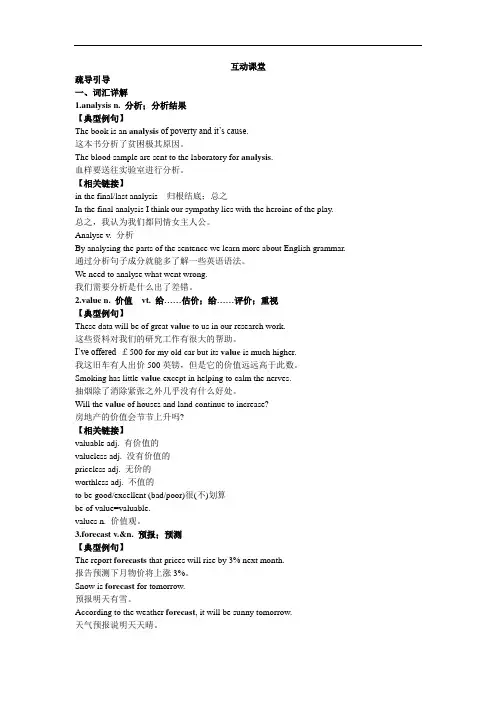
互动课堂疏导引导一、词汇详解1.analysis n. 分析;分析结果【典型例句】The book is an analysis of poverty and it’s cause.这本书分析了贫困极其原因。
The blood sample are sent to the laboratory for analysis.血样要送往实验室进行分析。
【相关链接】in the final/last analysis归根结底;总之In the final analysis I think our sympathy lies with the heroine of the play.总之,我认为我们都同情女主人公。
Analyse v. 分析By analysing the parts of the sentence we learn more about English grammar. 通过分析句子成分就能多了解一些英语语法。
We need to analyse what went wrong.我们需要分析是什么出了差错。
2.value n. 价值vt. 给……估价;给……评价;重视【典型例句】These data will be of great value to us in our research work.这些资料对我们的研究工作有很大的帮助。
I’ve offered £500 for my old car but its value is much higher.我这旧车有人出价500英镑,但是它的价值远远高于此数。
Smoking has little value except in helping to calm the nerves.抽烟除了消除紧张之外几乎没有什么好处。
Will the value of houses and land continue to increase?房地产的价值会节节上升吗?【相关链接】valuable adj. 有价值的valueless adj. 没有价值的priceless adj. 无价的worthless adj. 不值的to be good/excellent (bad/poor)很(不)划算be of value=valuable.values n. 价值观。
本文由一线教师精心整理/word可编辑Reading OneTeaching aims:1.Learn how to introduce one’s school.2.Learn the new words about school place.Teaching difficulties:Tell the difference between in/wear; also/ too; in front of/ in the front ofTeaching Steps:Step One: Pre-readingFirst, I’d like to teach the new word “building”. Listen carefullyThere is only one building in our junior middle school, but there are at least four buildings in our senior high school.Q: 1. What’s the meaning of the word “building” here ?2. Where do you have your music lesson/ art lesson/ computer lesson/ PE lesson?3. Where do you borrow books?4. Where does our grade have a meeting?5. Which floor is the school hall on?At the same time write down these words on the blackboardart room; music room; computer room; library; playground; school hall; on the ground floor Step Two:while readingToday is the Open Day in Millie’s school. Millie is ready to show her mother around her school. Write down the phrase “show around ” on the blackboard.Read fast and do exercises in Part B1; B2; B3Q: How does the library look?What does Millie’s English teacher look like?Write down the word “modern” and “a man in a white shirt ” on the blackboard.Step Two:Post-readingRead the passage twice and do the exercise in Part B4Read Part B4 together.Introduce Millie’s school with the help of the words on the blackboard.Step Six Homework补20页;评31, 32页1 / 1。
Welcome to the unit课前预习:一、写出下列单词划线部分的音标,试读,并写出其中文意思Walking reallyBowl timeTennis volleyball二、翻译短语和句子1.like walking______________________________________2.many times a day__________________________________3.fun sports________________________________________4.What’s your favouirte sport?_________________________________________________5.I often play football afterschool. What about you ?语法精讲:1. I walk to my bowl many times a day. 我每天都往我的饭盆那儿走好多次。
句中的time 意思是,是否可数Time还可以表示,是否可数eg..1)我每周上三次舞蹈课。
I go to my dancing lesson2)几点了?What is it?Many times a day 表示频率,对其提问,疑问词是I walk to my bowl many times a day (对划线部分提问)2. What about you ?What about = 意思是句型:…怎么样?做某事如何?其肯定回答是:3.play football/volleyball 等体育运动类短语间不需要加,然而弹奏乐器必须加,举例说明4. What’s your favouirte sport? =巩固练习:用所给词的适当形式填空。
1.D o you like playing ________(排球)2.I love ______________(walk)my dog after dinner.3.Are they good at ___________(swim) in the river?4.Does he enjoy _______________(listen) to music in his free time?5.What does your cousin love __________(do) at scholl?二、对划线部分提问1. My favourite sport is playing football.2. I go to work five days a week. Do you ?Reading课前预习:Player memberClub freeDream true二、翻译短语和句子1.my favourite football star_________________________________________________2. a new member of Huanghe Football Club ___________________________________3) come from Guangdong _________________________________________________4)look strong __________________________________________________________5) play football very well__________________________________________________6) in his free time________________________________________________________7) come true____________________________________________________________8) play in the next World Cup_______________________________________________课文探究:一、Li Hua’s ProfileName: _________________________________Age:___________________________________Birthplace:______________________________Living place:____________________________Team:__________________________________Looks:________________________________Hobbies:________________________________Next match:_____________________________二、简单复述李华语法精讲:1I like football very much.1)表达非常喜欢…,用like…very much句型e.g. 我非常喜欢中国2)对very much.提问,即对程度提问,用How…,2. He is a member of Huanghe Football Club. 他是黄河俱乐部的一员。
Unit 1 This is me!Comic strip & Welcome to the unitI. Teaching aims and learning objectivesBy the end of the lesson, students should be able to:1. know the two cartoon characters, Eddie and Hobo, and the six students at Sunshine Middle School;2. greet each other properly in English;3. introduce oneself to others in English.II. Teaching contents1. New words and phrases: master, e-dog, good morning/good afternoon/good evening/good night2. New structures:What’s your name?My name is …Nice to meet you.Nice to meet you, too.III. Focus o f the lesson and predicted area of difficultyHow to introduce each other and greet each other in English.IV. Teaching proceduresComic stripStep 1 Lead-in:Enjoy the video “make friends”.T: Today we’ll learn U nit 1 This is me! Do you like the song in the video? We are now new students at Donglin Middle School, and meet many new classmates. Do you want to make more friends? I’d like you to meet two new friends in our books. Do you want to know them?【设计意图:由视频再到图片make friends引出不同人物的名字。
】Step 2 Presentation1. Learn some new words(1) Show some pictures of the two cartoon characters.T: Look at the dog. His name is Eddie. Do you have a dog at home? If you have a pet dog, you are the master of the dog. You should look after it every day. And this is Hobo. They are our new friends.(2) Learn more about the words by showing more examples.2. Watch the video between Eddie and Hobo, and answer the following questions.T: Now let’s watch a video between Eddie and Hob o. Please watch carefully and answer the questions below.(1) What are the two dogs’ names?(2) Who is the master?(3) Is Hobo a real dog?(4) Is Hobo happy in Picture 1? Why?(5) Is Hobo happy in Picture 4? Why?3. Listen to the tape and follow in chorus. Pay attention to the pronunciation and intonation.4. Fill in the blanks of the passage, and check the answers.5. Read the conversation in pairs. Encourage students to add some facial expressions and body language if necessary.6. Demonstrate the conversation to the whole class.T: Great! Now I’d like to invite some pairs to come to the front and role-play for us. Who wants to have a try?【设计意图:通过图片呈现导入生词和短语,引出comic strip对话。
通过问答、填空和朗读让学生理解漫画内容并加以巩固。
】Welcome to the unitStep 1 Prese ntation1. Show pictures of the six students at Sunshine Middle School, and introduce their names.2. Read their names together.3. Show more pictures about these students in part A, and show how togreet people at different time.4. Finish Part B and read together.5. Read the three conversations in Part A together.【设计意图】通过呈现图片和部分对话让学生填入所缺答语的形式导入生词和短语,同时根据每张图片的内容师生现场演绎该段对话,增加学生印象,同时达到锻炼口语交际能力的目的。
Step 2 Practice1. Listen to the conversation in part C, and answer the question. Who are the two girls in th e conversation?2. Repeat after the tape, and pay attention to the pronunciation and intonation.3. Work in pairs. Greet your partner and then introduce yourself. Use the conversation below as a model.A: Hello./Hi./Good morning …B: Hello./Hi./Good morning …A: I’m … /My name is … What’s your name?B: I’m … /My name is …A: Nice to meet you.B: Nice to meet you, too.【设计意图】让同桌互相进行自我介绍并打招呼,操练对话,将知识点的运用融入到日常生活中。
Step 3 ExpansionShow some slang expressions and let students guess their meanings. T: Today, we have two new friends, Eddie and Hobo. They are both lovely dogs. And in foreign countries, dogs are human’s good f riends. They are honest, and do lots of things for us. Now, I have some slang expressions in English. Who can have a guess and tell the meanings?Love me, love my dog. 爱屋及乌。
It’s raining cats and dogs. 天正下着倾盆大雨。
work like a dog 拼命工作Every dog has its day. 每个人都有得意或成功的一天。
【设计意图】通过言语扩充学生知识面,提高学习兴趣。
Step 4 ConsolidationTranslate t hese sentences into English.1. 我爱电子狗。
I love e-dogs.2. 你叫什么名字。
What’s your name?3. A: 你是埃迪吗?Are you Eddie?B: 是的。
Yes, I am.【设计意图】通过句子翻译,让学生更好地加深对课堂内容的理解。
V. Homework1. Read the new words and dialogues;2. Finish Exercise One.Unit 1 This is me!Reading (I)I. Teaching aims and learning objectivesBy the end of the lesson, students should be able to:1. fluently read the passage about the four students at Sunshine Middle School;2. find out some detail information about the passage by reading carefully;3. introduce oneself and others in English.II. Teaching contents1. New words and phrases: grade, student, reading, classmate, slim, be good at, after scho ol2. New structures:I have short hair.Her hair is long.Let’s meet my new classmates.I love reading.He is from Nanji ng.He’s good at Maths.III. Focus of the lesson and predicted area of diffi cultyLearn how to introduce others and oneself.IV. Teaching proceduresStep 1 Lead-in1. Show the picture of Hermione, a character from the movie series Harry Potter. And present ne w words and phrases by showing her profile.2. Match the words and phrases with the meanings.3.Make a conclusion about how to introduce a person: name/age/birthplace/appearance/hobby.【设计意图;简要总结如何描写人物的思路,同时拓展更多相关词汇,形成文章脉络并锻炼学生的总结能力。